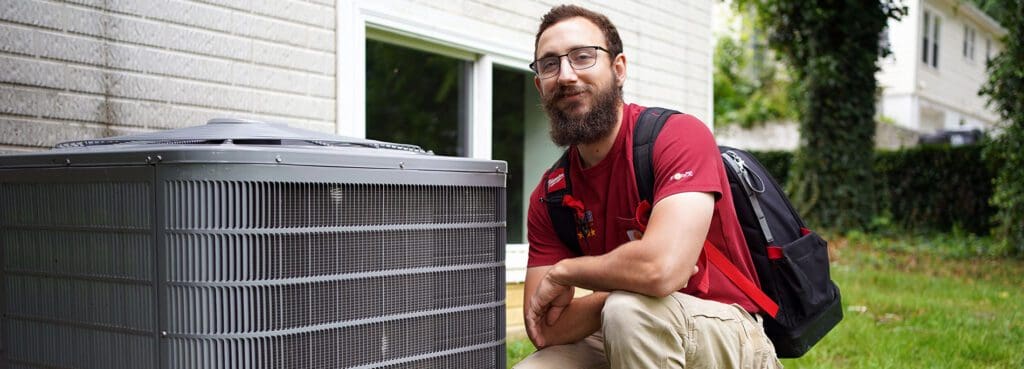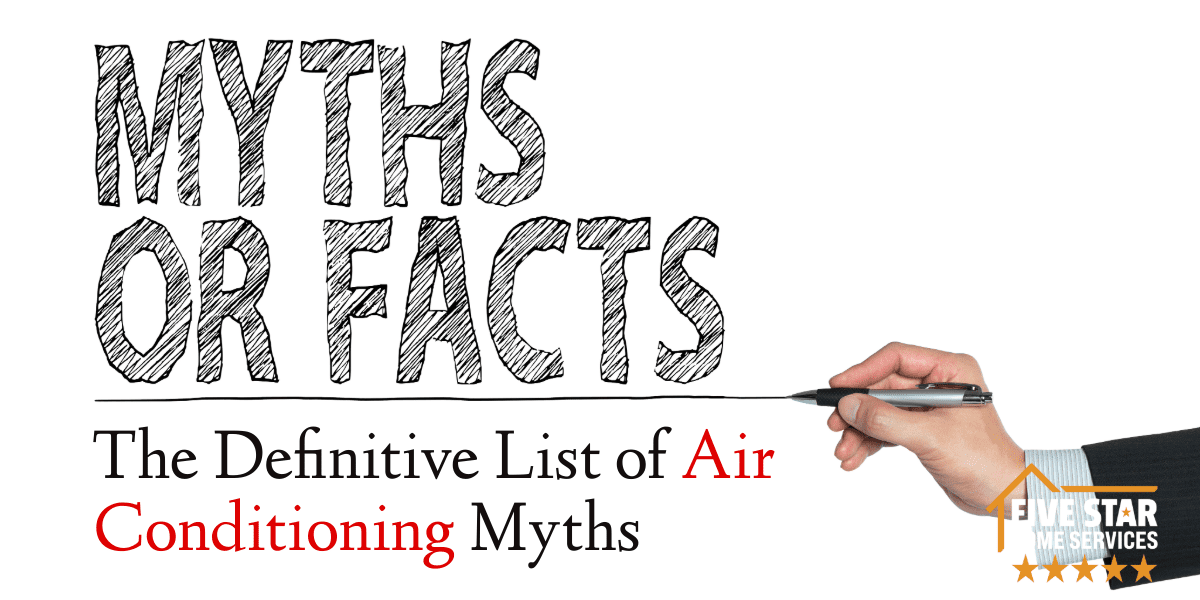Air conditioners are a staple in modern homes, and most of us can’t imagine an Ohio summer without one. Nevertheless, many homeowners misunderstand several common concepts regarding central cooling equipment. Your friends at Five Star Home Services will delve into some of these misconceptions in the following!
The Definitive List of Central Air Conditioning Myths
It’s an unfortunate fact of our modern age: Misinformation is everywhere. It’s not only in mainstream news but also in our workplaces and everyday lives. It can also concern our home and the systems that help to maintain it. While we aren’t able to tackle all of these things, we do know HVAC systems better than anyone. At Five Star, we pride ourselves on providing our customers thorough information on various topics, including misconceptions and myths.
Because HVAC equipment and processes are complicated, this isn’t something a lot of people have to think about often. When they do, they often have a lot of misconceptions about how the equipment works, and how to get the most out of it. So we are here to set the record straight! We will explore every common air conditioning myth we have encountered over the years. At Five Star, our experts have hundreds of years of combined experience in the HVAC industry. As a whole we’ve been in this business for more than half a century! By leveraging all this experience to your advantage, we hope to dispel as many myths as possible, and answer them as thoroughly as possible. If we miss anything, please let us know!
Common AC Equipment Myths
Myth: Price is the most crucial factor when purchasing a new central air conditioner.
Fact: Sorry to burst your bubble, but this is wrong on a couple of different accounts. Whether you are looking for the lowest cost or most superior system, the total price tag is only one factor to consider. The quality of the installation is the most important factor in whether or not you’ll have an efficient, quality system. This makes choosing the right installer more important than the price.
At Five Star, we ensure precise sizing, and absolutely no corners are cut during the installation. The support you receive from us determines the long-term cost and long-term value of your system.
Myth: When it comes to central air conditioners, bigger is always better.
Fact: Don’t fall for this one. All HVAC contractors should perform a Manual J Load Calculation when they first visit your home. We need to determine the correct size system for your home. More size (referred to as tonnage) does not equate to better cooling or reduced energy bills. In fact, it can even be worse in both of those areas due to starting and stopping more frequently.
Myth: Central air conditioners only cool the air.
Fact: Air conditioners are also effective humidity removal systems. This, in turn affects, your overall comfort. Evaporator coils inside a central air conditioner absorb moisture. It then transmits it to the outdoor air conditioner. From there, it gets expelled into the air. As a result, running your air conditioner can help to reduce and control humidity levels in addition to keeping you and your home cool.
Myth: Furnaces and Air conditioners operate as separate systems.
Fact: These two systems share several common features. For one, the blower fan in your furnace moves air throughout your home for both heating and centralized air conditioning. As a result, the fan’s settings need to match the available settings on your air conditioner. Otherwise, the air conditioner won’t function efficiently. This is known as “equipment matching.” It is a big reason why it’s often recommended that you replace your air conditioner and furnace at the same time.
Myth: My SEER Rating is all I need to worry about as far as efficiency is concerned.
Fact: While Seasonal Energy Efficiency Ratio ratings are a good gauge of potential efficiency, they are far from being the only factor. A bad installation, when compared to a good installation, is a far bigger differentiator of efficiency and expected lifespan than the SEER Rating. Additionally, many other factors contribute to efficiency, including the status of your equipment, how clean (or dirty) your air ducts are, and if your filter is clogged enough to inhibit airflow in the system.
Myth: My AC refrigerant was banned, so I need to replace my air conditioning system right away.
Fact: While the federal government has indeed banned the R22 refrigerant most common in AC systems, it was only done so for new production and new installation. If your existing system uses R22, you are not obligated to replace it immediately. You are grandfathered into the new law. However, with no new refrigerant production in the country, “topping up” your system with R22 is only going to become increasingly expensive in the coming years and months.

Common A/C Maintenance Myths
Myth: Seasonal maintenance is only important when my air conditioner has issues.
Fact: This is one of the more dangerous myths we encounter because it’s easy to believe when everything seems to be going well. Regardless, central air conditioners should receive yearly maintenance regardless of its operational status. The reason for this is that maintenance is proactive, and not reactive. To wait for problems is to react rather than prevent. This will cost you comfort and money. Remember, an ounce of prevention is worth a pound of cure.
Additionally, if you are within your warranty, which is usually about 10 years, no one will honor that warranty if it isn’t being serviced annually. In any case, make sure you’re reading the warranty carefully. This language is certain to be in there. Last but not least, if you’re losing efficiency while taking years off of the life of your system by neglecting regular maintenance, it will catch up with you sooner or later.
The difference is that of an AC system that lasts you 8 to 12 years at best, and one that lasts 15 to 20 years.
Myth: Because I don’t own any pets and keep my house clean, I can go a full year without changing my air filter.
Fact: Air filters can clog faster in homes with people who smoke, pets, and other environmental considerations. However, particles in your HVAC air supply won’t get caught by regular house cleaning. Typically, one-inch air filters must be replaced every 30 to 90 days. Four-inch filters need to be replaced on average every six months. At this rate, they can fluctuate slightly from home to home. Nevertheless, that range isn’t widen much, regardless of your circumstances.
Myth: I’m wasting money if I replace my central air conditioner before it dies.
Fact: If your AC is on its last legs, chances are you’re already losing a lot of money alongside optimal comfort! Older units don’t operate anywhere near their maximum efficiency. Secondly, most air conditioners break down when you start to need them, the first time you try using them that year. This is almost always the first unbearably hot day of the spring or early summer. There’s a rush for installations and service during these days. It can delay days or even weeks while you’re waiting for service. Overall, this isn’t worth the risk. If it’s older and closer to dying, you’ll have to replace it sooner or later. Why not try saving on utility costs now instead of later?
Home comfort equipment only gets more expensive from year to year! Because of this, a conversation with a trusted HVAC partner like Five Star Home Services can help you determine when it makes the most sense to replace your existing equipment.
Common A/C Comfort Myths
Myth: Turning Your Air Conditioner Off When Away Will Save You Money
Fact: While this is undoubtedly false, it’s also tricky. Potential costs depend on things like the type of equipment you have and how long you’re away from the home. There are sophisticated variable-speed air conditioners that often make sense to leave on indefinitely during the summer months. In any case, if you work long hours on certain days, lowering your air conditioner’s output during those hours can save you money.
Another better strategy is using a smart thermostat or programmable thermostat to make the temperature five degrees warmer when you’re not home. Instead of going from “very hot” to “comfortable” within minutes of your arrival home, you can save some money while avoiding the risks associated with turning off the unit entirely. In fact, smart thermostats automate this process.
Another reason to avoid turning the unit off entirely is the humidity. Humidity can cause all kinds of problems. Air conditioners are adept at managing humidity levels. By leaving them on, you avoid long-term problems due to high humidity in the summer months.
Myth: Setting your thermostat lower cools, the house more quickly.
Fact: If your temperature is 80 degrees and you set your thermostat to either 72 or 70, it will cool to 72 degrees just as quickly in either case. Setting it to 70 just means it will stay on longer to reach 70 degrees once it’s at 72. This myth originates from the fact that variable-speed air conditioning systems operate at hundreds of different speeds. Because of this, they aren’t always meant to go at 100% output.
Myth: Closing air vents helps save money on central air conditioning costs.
Fact: Because the cool air from your air conditioner is mixed with the warm air in your home, this creates hot and cold spots until the air mixes up to arrive at the desired temperature levels.
For clarity, this is different from “zoned” houses, which do have separate areas. Zoned homes can save money by providing air to only certain sections or zones. Nevertheless, we should note, this is something that is set up deliberately. Zoning usually only applies to commercial properties. Although it can be set up in residential homes as well, closing vents is not a good way to try to recreate its benefits.
Myth: The thermostat can go anywhere and will always work the same.
Fact: Thermostat placement is of the utmost importance because exposure to airflow and sunlight can drastically affect its readings. Additionally, it’s important to place it in an area that’s representative of the temperature throughout the home. If you’ve ever had a cold basement at the same time as a hot upstairs, you know the importance of even cooling throughout a home.
Because of this, you need to install your thermostat on an interior wall that isn’t exposed to the sun or airflow. Some systems use sensors throughout the home, which increases the accuracy of the readings taken by the thermostat and allows the system to better cool your home.
Myth: Air conditioning can make you sick.
Fact: For starters, let’s say that air conditioning by itself won’t make anyone sick. However, if your home has diseases, irritants, or pollutants, failing to manage your HVAC system properly can allow them to stay in your home and increase the risk for sickness.
The first step in the right direction is proper filtration. Investing in a high-quality air filter and replacing it appropriately is essential. Correct humidity control can also help to avoid molds that develop during the hot and humid months. Last but not least, indoor air quality products can help eliminate contaminants and diseases. We offer the best prices on IAQ products at Five Star Home Services.
Myth: Ceiling fans can help lower air conditioning energy costs.
Fact: This statement isn’t without a kernel of truth. Ceiling fans move air but don’t do anything to cool it. If your central air conditioner works as hard to get to the desired temperature with or without fans. Where fans can work is in helping us feel comfortable at slightly higher temperatures. If you’re in a room with a fan, perhaps you’ll feel comfortable at 74 instead of 72, and you will be able to dial back your thermostat. If used like this, you can get some savings out of them. They can also circulate the heat during the winter as heat rises. In any case, smart use of fans can contribute to energy savings, but in and of themselves, they’re not cooling the air.
Still Have Questions? No Worries! Your Friends At Five Star Has Answers!
Because this list isn’t comprehensive, we encourage you to call us for more information. We couldn’t possibly include every single question we received. Nevertheless, we did try to boil them down to the ones we hear most frequently, in addition to those with the biggest implications for your HVAC equipment. Because bad information is the enemy of good decisions, our ongoing goal is to provide educational materials, information and resources to our amazing customers.
In the meantime, when it’s time for you to make your next HVAC investment and decide to have a new system installed, you are undoubtedly going to have questions. No other HVAC contractor is going to be
able to predict them all. That’s why it’s essential to sit down with a trusted HVAC partner to resolve all questions and concerns, making the best decision for you, your home, and your family possible.
If you’d like to talk more, please call Five Star Home Services today at (833) 405-8009

